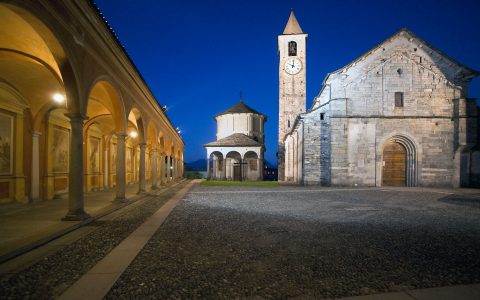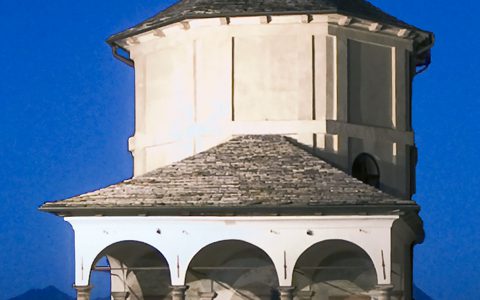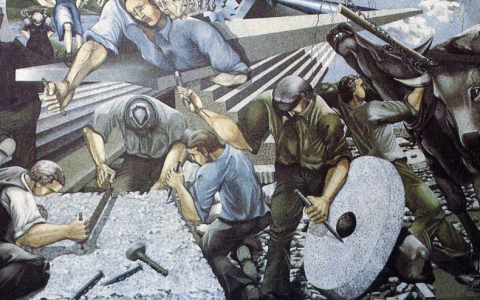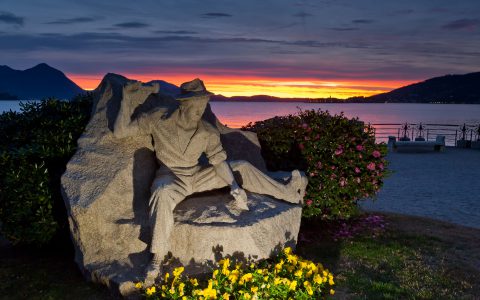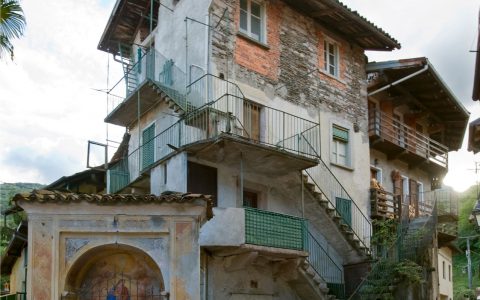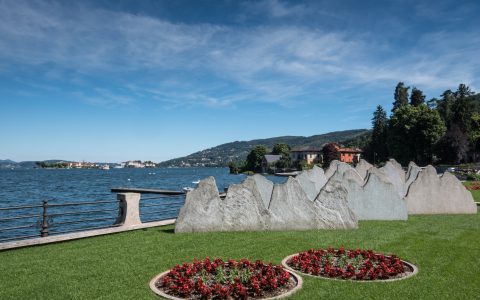Places and monuments
St. Gervaso and Protaso Church
The architecture, enhanced by the clear colour of square stones, presents on the front two walled tombstones of Roman age that together with the other features of the site, a balcony on the lake turned to the rising sun seem to corroborate the hypothesis that the church was built on a site of pagan cult. The “a capanna” façade is a wonderful example of Roman architecture (1150-1175), covered with beole (flat stones typical of the Ossola Valley) and the bell tower (1050-1075), six-storey high on a square base, walled single lancet windows and masonry in pebbles placed in an irregular manner. The interior is the result of different interventions, with frescos of the XV century, interesting altar frontals in the side chapels added in 1700, two panels attributed to Defendente Ferrari (XVI Century) and an “Annunciation” by Camillo Procaccini (1551-1629). On the central vault, the precious wooden Crucifix has on the background a vision of the “Golgotha” mountain, frescoed by Andrea Francinetti and Giovanni of Gignese (mid 1800).
Baptistery
Some authors date in back to the V century and this suggestion has recently confirmed by specific archaeological excavations. The exterior resembles a building of the XVIII century, preceded by a porch with granite columns on a square plan to which corresponds an internal octagonal space with alternate rectangular and semi-circular niches carved into the wall. The decorations of the ribbed vault and of the walls were realized between 1400 and 1800.
Way of the Cross
The sacred perimeter is bounded by a series of porches that characterize the “Via Crucis”, realized in 1839 after the transfer of the cemetery. The route of the stations of the Cross has incorporated an ancient funeral chapel, devoted to the Sepulcher that contains a wooden statue of Christ and the instruments of the Passion of Christ. 
The mural
The wall painting in Matteotti Square of Baveno carried out in 1979 by Gilberto Carpo with the help of the students of the arts centre ‘Circolo Bavenese’ is dedicated to the Picasass, the stonecutters of Baveno, whose ability is world known since many centuries. Carpo, to develop the theme chosen by a popular assembly, used the testimonies of stonecutters in order to grasp the complexity of their trade, both in its craftsmanlike and creative dimensions and in its evolution, represented at the top of the painting by mechanisms that create lines and geometrical forms, symbols of mass production. A photograph of the manufacturing of one of the columns of the Duomo of Milan was the starting point for the column that crosses the painting in perspective. Women are portrayed with the “gaula” (a sort of pannier) used to transport pyric powder. This painting is expression of the historical movement ‘New Italian Figuration’.
Granum Museum
The “Granum” museum, located in the old Municipal Hall, is a multi-medial and multi-sensorial experience dedicated to Pink granite and its historical and economic importance for Baveno. The museum also documents the variety of sites where granite is quarried throughout the Verbano-Cusio-Ossola Province. To this end, Granum works in cooperation with other cultural realities within the territory of the " Granites of the lakes" and the Ecomuseum of Montorfano’s Granite. The exhibition area is divided into 4 thematic sections, starting with the presentation of pink granite and the characteristics of the most notable types of stone in the area. This is followed by a section dedicated to the extraordinary mineralogical rarities discovered inside the Baveno granite quarry with a display of some of the finest crystals found over the years. Exhibits in the third section illustrate work in the quarry and the processing of granite, both today and in the past. The final section documents the history of quarrying here and how the granite has been used locally and abroad.
The Stonecutter’s monument
Walking along the lakeside of Baveno you can admire the stonecutter’s monument , of course in pink granite of Baveno, created by the local sculptor Raffaele Polli. The monument represents a young “picasass” (stonecutter) at work, dealing with a block in appearance without any value, but from that granite he will create with difficulty, but with passion, a true work of art.
Villa Fedora
Surrounded by the municipal park of Baveno there is Villa Fedora, a 19th-century residence. It was the scene of joyous and sinister events: The famous musician Umberto Giordano lived here; In the Second World War Villa Fedora was a refuge for a jewish family, which has met a tragic fate; During the years it became also an institution for needy mothers and children. The villa currently belongs to and is the headquarters of the Chamber of Commerce of Verbano-Cusio-Ossola, which has recently renovated some parts of the building. The luxuriant English style park is home to oak trees, camellias, mimosas and azaleas and is open to the public. During summertime, thanks to its beautiful and long beach, it’s one of the favorite places for families and visitors.
Domo and Baitone
The two oldest part of the town are called “Domo” and “Baitone”.
East of the Church, a narrow alley (Domo street) links the monumental Complex of St. Gervaso and Protaso with the little picturesque square of the old area of Domo (the Latin translation of Domus means house). Here a low building with a stone roof and a big chimney was the ancient public over. Opposite stands the chapel with a fresco dedicated to the Virgin Mary built to express thankfulness for her intervention to quell the pestilence in 1630. Just behind the oldest house of Baveno “casa Morandi” built in the 18th century with external staircases and balconies. The square is the favorite corner for painters and photographers. On the side of the ancient oven a stone underpass leads to the lakeside.
With its old little votive chapels and the colorful [...]houses leaning against each other, with their animated and vibrant courtyard, the tiny porticoes and the wooden balconies “Baitone” [...]is located north of the church with a maze of alleyways and stairways leading to the National Simplon road. There you can have a look at the big building hosting today a bank (Veneto Banca) but, in the 19th century, headquarters of the most ancient hotel of the lake “Hotel della Posta” place of rest provided for the stage coaches travelling through the Simplon Pass. Between the guests of the hotel Dumas and Schubert wrote some letters enjoying the beautiful view from their rooms.
War Memorial
The monument was built at the end of the First World War and consists of an elegant Corinthian column placed on a stand. The bronze group represent an old stonecutter’s farewell to his son before leaving for the front.
17 Martyrs Memorial
The memorial monument was built in the spring of 1946 for the 17 partisan boys , arrested in Valgrande few days before, and shot one by one by the nazifascist soldiers on the lakefront June 21, 1944 .
Flowerbed “lake and mountain”
The flowerbed on the lakeside of Baveno has an important meaning: the shaped vertical stones, remembering the mountain’s profile, are realized with the most important stones of the province of Verbania: silvery Gneiss , Mergozzo Green granite , pink granite of Baveno and Montorfano white granite. Water, stone and vegetation: typical elements of Lake Maggiore enhanced by the creativity and the work of the man. Designed by the architect Fabrizio Bianchetti in 1997.
The Town hall
The old town hall is now home to the tourist office, the Granum Museum and the public library and dates back , like the Church, the XI century. The present town hall was in the past a private house embellished with an arcade and pink granite columns . It was later restored in 1970.
Maggi
If Nessy is the family name of the Loch Ness monster , Maggi is the name of the pink granite snake located in the lakeside playground of Baveno . Too cute to be called "monster" allows to develop the imagination , as well as the muscles of the children racing to climb over it.




